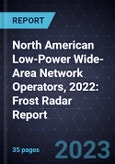Low-power wide-area networks (LPWANs) are gaining traction globally for their extended coverage, low transmission rate, long battery life, and beneficial cost savings in operations, capabilities that are determinantal to enabling massive machine-to-machine (M2M) and Internet of Things (IoT) deployment for non-mission critical applications.
Customers can deploy this technology over licensed and unlicensed spectrum bands. Cellular LPWAN is deployed in licensed bands, which ensures that capacity and coverage performance are guaranteed over the devices’ lifetime. Cellular LPWAN can be deployed in the GSM spectrum, within an LTE carrier, or in an LTE or wideband code division multiple access (WCDMA) guard band. In contrast, proprietary LPWAN is developed by providers over their own network in the unlicensed spectrum. Although the quality of service (QoS) is not as optimal as cellular LPWAN and interference can occasionally emerge, use of unlicensed bands is free.
While telecom operators are offering cellular LPWAN that includes narrowband-IoT (NB-IoT) and long-term evolution machine (LTE-M or Cat-M1), other companies are selling unlicensed LPWAN connectivity services with proprietary specifications, such as LoRaWAN® and RPMA®.
The North American LPWAN market is in a growth stage. The region had more than 134.1 million LPWAN connections in 2021. With recent LPWAN network rollouts nationwide and roaming agreements between partners, the number of connected devices is on track to increase at a CAGR of 44% from 2021 to 2025. Utilities are driving growth, as customers demand smart metering of water, gas, and energy. Asset tracking is another vertical that requires LPWAN technology to connect over long distances. Smart city and smart building initiatives also demand wireless connectivity for air quality monitoring, leak detection, traffic management, and smart parking use cases.
This Frost Radar™ benchmarks the leading LPWAN operators in North America, namely Verizon, AT&T, Ingenu, Everynet, Senet, MachineQ, eleven-x, and X-TELIA.
The Frost Radar™ reveals the market positioning of the leading companies in the North American LPWAN industry using their Growth and Innovation scores as highlighted in the Frost Radar™ methodology. The document presents competitive profiles on each of the companies in the Frost Radar™ based on their strengths, opportunities, and market positioning. It discusses strategic market imperatives and the competitive environment that vendors operate in as well as makes recommendations for each provider to spur growth.
Table of Contents
1. Strategic Imperative and Growth Environment
- The Strategic Imperative
- The Growth Environment
2. Frost Radar™
- Frost Radar™: Competitive Environment
3. Companies to Action
- AT&T
- eleven-x
- Everynet
- Ingenu
- MachineQ
- Senet
- Verizon
- X-TELIA
4. Strategic Insights
5. Next Steps: Leveraging the Frost Radar™ to Empower Key Stakeholders
- Significance of Being on the Frost Radar™
- Frost Radar™ Empowers the CEO’s Growth Team
- Frost Radar™ Empowers Investors
- Frost Radar™ Empowers Customers
- Frost Radar™ Empowers the Board of Directors
6. Frost Radar™ Analytics
- Frost Radar™: Benchmarking Future Growth Potential
- Legal Disclaimer
Companies Mentioned (Partial List)
A selection of companies mentioned in this report includes, but is not limited to:
- AT&T
- eleven-x
- Everynet
- Ingenu
- MachineQ
- Senet
- Verizon
- X-TELIA








